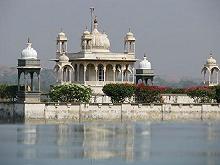|
|
| Introduction of Dungarpur |
|
Dungarpur is one of the important city of
the Vagad region in Rajasthan. Dungarpur is built around the
immense Gaibsagar Lake and surrounded by lolling hills on three
sides. The word Dungar means hills in the common language and
hence the Dungarpur means the city of hills. It has an
interesting topography, ranging from the wild and rugged terrain
in the north east to the fertile plains of the alluvial soil in
the south west. This region was also the stronghold of the Bhils. |

|
|
|
|
| History of Dungarpur |
|
Dungarpur was founded in the early 13th
century when Rawal Veer Singh constructed temples in the memory of
Dungaria’s widows. Dungarpur became famous under the Guhilot Ahara
Suryavanshi Rajputs, who trace their ancestry from the elder branches of
the main lineage at Chittorgarh. The cousins came together to fight the
historic battle against the invaders. Towards the end of the 12th century,
Samant Singh, the eldest son of the ruler of Mewar, had to leave Mewar in
favour of his younger brother Kumar Singh. Samant Singh drifted into the
hilly area of Bagar and, within the next century, Samant Singh successors
controlled the whole province of Bagar. Rawal Udai Singh of Bagar was
killed at the battle of Khanua in 1527, fighting for Mewar against Mughal
Emperor Babur. His territory was thereafter divided between his two sons,
forming two separate states. Prithivi Raj remained in Dungarpur while his
brother Jagmal Singh became independent ruler of Banswara. Dungarpur was
added as a district in India on April 7, 1949. |
|
|
| Tourist Attractions in Dungarpur |
|
The tourist
attractions in Dungarpur are the Udai Bilas Palace and Juna
Palace. Udai Bilas Palace is a good example of the Rajput
architecture with its intricately sculptured pillars and panels,
impressive balconies, bracketed windows and marvellous panels. The
Udai Bilas Place was built in the mid-19th century by Maharawal
Udai Singh-II, by the bluish-grey sandstone. The Udai Bilas Palace
has been now converted into a heritage hotel and still under the
control of the royal family of Dungarpur and a royal residence.
Juna Mahal is a seven storeyed structure, resembling a fortress
with crenellated walls, turrets, narrow entrances and corridors.
The interiors are embellished with beautiful frescoes, miniature
paintings, glass and mirror work. Another interesting palace to
visit is the famous shrine dedicated to the Shrinathji that lies
on the banks of the Gaib Sagar lake. Various lakes and forests in
Dungarpur attract a large variety of migratory birds during the
winters. |
|
|
| Festivals
in Dungarpur |
|
One of the major fair which is held
in Dungarpur is the Baneshwar Fair. The Baneshwar fair is held in
the month of February at Baneshwar, a small delta formed by the
river Soma and Mahi, about 50 km from Dungarpur. This fair is one
of the biggest and most important fair of the Bhils. 'Baneshwar'
means the ‘master of the delta’ and is derived from the Shiva
Linga kept in the Mahadev temple in Dungarpur. This is a religious
fair with simple and traditional rituals. The tribal folks of
Bhils gather here from the neighbouring states of Madhya Pradesh
and Gujarat and offer prayers to Lord Shiva.
|
|
|
|
How to reach Dungarpur |
|
By Air:
The nearest airport is located at Udaipur, which is about 120 kms away and
Ahmedabad is about 175 kms away.
By Rail:
There are frequent trains from Ahmedabad, Udaipur and Jaipur to Dungarpur.
By Road:
Dungarpur is just 25 km from national Highway 8, approached either from
Ahmedabad or Udaipur.
To know the distances
from Dungarpur click
here. |
|
|